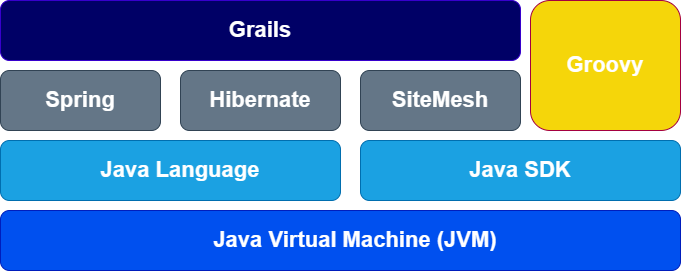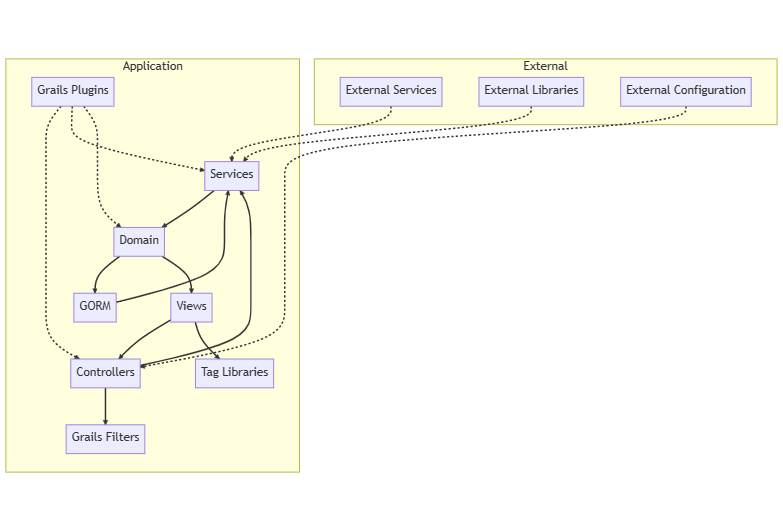The world of web development is constantly evolving, with new frameworks and libraries being introduced regularly. One such framework that has gained popularity in recent years is Grails.
In this article, we will provide an in-depth introduction to the Grails framework, reasons to choose Grails, its architecture, and components. By the end of this article, you will have a solid understanding of the Grails and will be able to decide whether it’s the right choice for your next web application project.
Table of Contents
Introduction to Grails Framework:
What is Grails?
Grails is an open-source, full-stack web application framework that provides a Convention over Configuration (CoC) and Don’t Repeat Yourself (DRY) approach, allowing developers to get started quickly without having to configure every aspect of the application. It is built on top of the Spring Boot framework, which provides a solid foundation for developing modern, high-performance web applications. Grails utilizes the Groovy programming language. Groovy is a dynamic, object-oriented language that runs on the Java Virtual Machine (JVM). It is designed to be easy to learn and use, with a syntax that closely resembles Java.
Grails simplifies the development process by focusing on simplicity, ease of use, and developer productivity, meaning that developers can focus on writing code without worrying about the underlying infrastructure. The framework follows the Model-View-Controller (MVC) architectural pattern, a tried-and-tested design pattern that helps to separate the application’s concerns and promote maintainability. Grails is known for its seamless integration with Java and other JVM languages, allowing developers to leverage existing Java libraries and infrastructure. This makes it an ideal choice for organizations with a Java background that are looking to modernize their web applications.
Why use Grails?
There are several reasons to choose Grails as the web application framework for your next project. Some of the most compelling reasons include:
1. Rapid application development:
Grails incorporates sensible defaults, automatic configuration, and code generation capabilities such as scaffolding, which generates code for common tasks, and plugins, which provide additional functionality that can be easily integrated into an application. These features can save developers a lot of time and effort, allowing them to get started quickly and focus on writing their application’s core functionality.
2. Dynamic and flexible:
Grails leverages the power of Groovy, a dynamic and flexible programming language that is both easy to learn and powerful enough to handle complex tasks. Groovy’s syntax is similar to Java, making it accessible to Java developers. Its dynamic nature allows for rapid prototyping and a more expressive codebase. Grails is built on top of a modular, plugin-based architecture that makes it easy to add new features and functionality to your application. There are a plethora of plugins available for Grails, covering everything from authentication to caching to data visualization.
3. Convention over Configuration:
Grails follows a convention-over-configuration approach, which minimizes the need for boilerplate code and configuration files. This allows developers to get started quickly without having to configure every aspect of the application. They can focus on writing code instead of worrying about configuration details.
4. Seamless integration with the Java ecosystem:
Grails is built on top of the Spring Boot framework and is fully compatible with the Java platform. This means that developers can take advantage of the vast array of Java libraries and tools available while still benefiting from the productivity gains provided by Grails.
5. Modularity and extensibility:
Grails is built on top of the Spring Boot platform, which provides a modular and extensible architecture. This allows developers to easily add new features and functionality to their applications by leveraging a wide variety of plugins and libraries.
6. Robust plugin system:
Grails features a robust plugin ecosystem that enables developers to extend the framework’s functionality and easily integrate third-party libraries. There are plugins available for various tasks, such as database connectivity, authentication, and caching, making it simple to add new features to your application.
7. Built-in Testing Support:
Grails provides built-in support for testing, including unit testing, integration testing, and functional testing. This makes it easier to write and maintain tests for your application, which can help improve its quality and reliability.
8. Powerful Object-Relational Mapping (ORM):
Grails uses the Hibernate ORM to interact with databases. Hibernate provides a number of features that make it easier to work with databases, including automatic mapping of objects to database tables and support for caching. Grails also provides a powerful and flexible ORM system called GORM, which makes it easy to work with databases and optimize performance.
9. Simplified Dependency Injection:
Grails uses the Spring Framework for dependency injection, which allows you to easily manage dependencies between different components of your application. Dependency injection makes it easier to write modular and testable code.
10. REST APIs, React, and Angular Integration:
Grails offers a versatile approach to building robust REST APIs and modern web applications using popular JavaScript frameworks like React and Angular. Application profiles in Grails enable seamless integration with these frontend technologies, simplifying the development process and allowing developers to create full-stack applications with ease. By combining the power of Grails with React or Angular, developers can create highly scalable and maintainable applications while benefiting from the convention-over-configuration approach that Grails is known for.
11. Asynchronous Capabilities:
Grails simplifies concurrent programming by offering a suite of powerful asynchronous features. These capabilities include the concept of Promises, which streamline the management of asynchronous tasks, a unified event model for efficient event handling across your application, and integration with RxJava to enable reactive programming. By leveraging these features, developers can create responsive and scalable Grails applications that can handle high levels of concurrency while maintaining a clean and maintainable codebase.
12. View Technologies: GSP, JSON Views, and Markup Views:
Grails makes it easy to generate different types of content, such as HTML, JSON, and XML, using its variety of view technologies. These include GSP, JSON Views, and Markup Views, which help developers create dynamic and data-driven content for web applications, APIs, and more.
GSP: Grails’ Groovy Server Pages (GSP) enable developers to effortlessly build HTML content by blending the power of Groovy with familiar HTML syntax.
JSON Views: JSON Views in Grails simplify the process of creating structured JSON content, making it straightforward to build data-rich APIs or web applications that rely on JSON data.
Markup Views: With Markup Views, Grails allows developers to generate XML content and other markup languages in a clean and maintainable way, catering to a wide variety of use cases.
By using these view technologies, developers can create consistent and easy-to-maintain presentation layers for their Grails applications.
13. Active community:
Grails has an active and vibrant community that contributes to its growth and development. This ensures that the framework stays up to date with the latest trends and best practices in web development.
If you’re looking for a step-by-step guide on how to install Grails on Windows, Mac, or Linux, check out our article ‘Installing Grails on Windows, Mac, and Linux: A Step-by-Step Guide‘ for detailed instructions.
Grails architecture and components
Grails follows the Model-View-Controller (MVC) architectural pattern. This pattern divides an application into three main components: the model, which represents the application’s data and business logic; the view, which is responsible for displaying the data to the user; and the controller, which handles user input and manages the flow of data between the model and the view.
In Grails, these three components are represented by the following:
1. Domain classes:
Domain classes are the application’s data model, representing the entities and their relationships within the application. In Grails, domain classes are written in Groovy and are automatically mapped to database tables using the Hibernate Object-Relational Mapping (ORM) framework.
2. Controllers:
Controllers in Grails are responsible for handling user input, processing requests, and managing the flow of data between the model and the view. Controllers are written in Groovy and follow a convention-over-configuration approach, meaning that Grails automatically maps URLs to controller actions based on naming conventions.
3. Views:
Views in Grails are responsible for rendering the data provided by the controllers and presenting it to the user. Grails supports several view technologies, including Groovy Server Pages (GSP), which is the default view technology. GSP is a powerful, easy-to-use templating language that allows developers to create dynamic HTML pages using familiar syntax and constructs.
In addition to the core MVC components, Grails applications also include the following:
1. Services:
Services in Grails are used to encapsulate reusable business logic and can be easily injected into controllers and other services using Grails’ dependency injection capabilities. Services are written in Groovy and are automatically managed by the Grails framework.
2. Plugins:
Plugins are a key feature of Grails that allow developers to easily add new functionality to their applications. Grails includes a wide variety of built-in plugins and supports the creation of custom plugins. Some popular plugins include the Spring Security plugin for authentication and authorization, the Asset Pipeline plugin for managing static assets, and the Quartz plugin for scheduling tasks.
3. Configuration:
Grails uses a convention-over-configuration approach, which means that sensible defaults are provided for most application settings. However, developers can easily customize these settings using Grails’ flexible configuration system. Configuration files are written in Groovy and are organized into hierarchical environments, making it easy to manage settings for different deployment environments (e.g., development, production).
4. Testing:
Grails includes built-in support for unit testing, integration testing, and functional testing. Developers can write tests using the Spock testing framework, which is a powerful, expressive testing framework for Groovy and Java applications. Grails also includes support for code coverage analysis using the JaCoCo plugin.
As mentioned earlier, Grails follows the principles of Convention over Configuration (CoC) and Don’t Repeat Yourself (DRY). This means that the framework has a set of default conventions that simplify the development process and reduce boilerplate code.
Some of the key Grails conventions include:
URL mapping:
Grails automatically maps controller actions to URLs based on their names. For example, the index action of the BookController class would be mapped to the /book/index URL.
Scaffolding:
Grails provides a scaffolding feature that allows developers to quickly generate code for creating, updating, and deleting domain objects. This can save a lot of time and effort during the initial stages of application development.
Configuration:
Grails provides sensible default configurations for various aspects of the application, such as data sources, logging, and internationalization. Developers can easily override these defaults by providing their own configuration files.
Naming conventions:
Grails follows a set of naming conventions for various components, such as controllers, views, and services. This makes it easy for developers to understand the structure of a Grails application and quickly locate specific components.
Conclusion
In this article, we’ve provided an in-depth introduction to the Grails framework, including its architecture, components, and key benefits.
Whether you’re an experienced developer or just starting out, Grails is a powerful and flexible framework that can help you create high-quality web applications with ease.
So why not give it a try and see how it can take your development skills to the next level?
Don’t forget to subscribe to our blog for more web development tips, tutorials, and insights.



Thank you Rahul Sir
This infomation is very usefull to us,